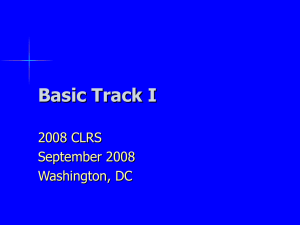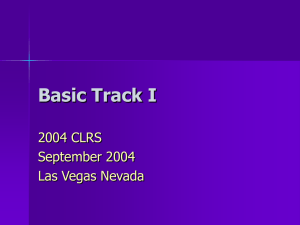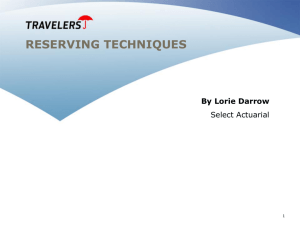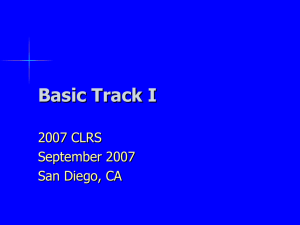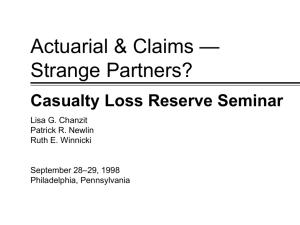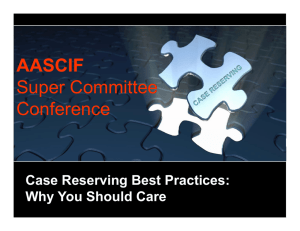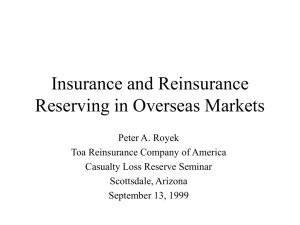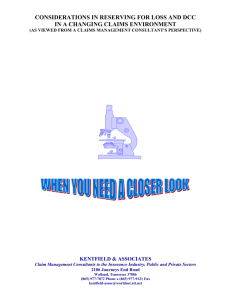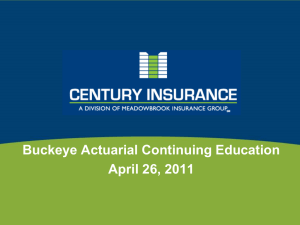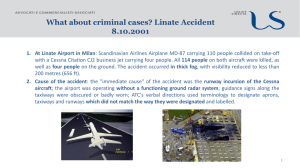Lecture Notes 4 - University of Illinois at Urbana
advertisement
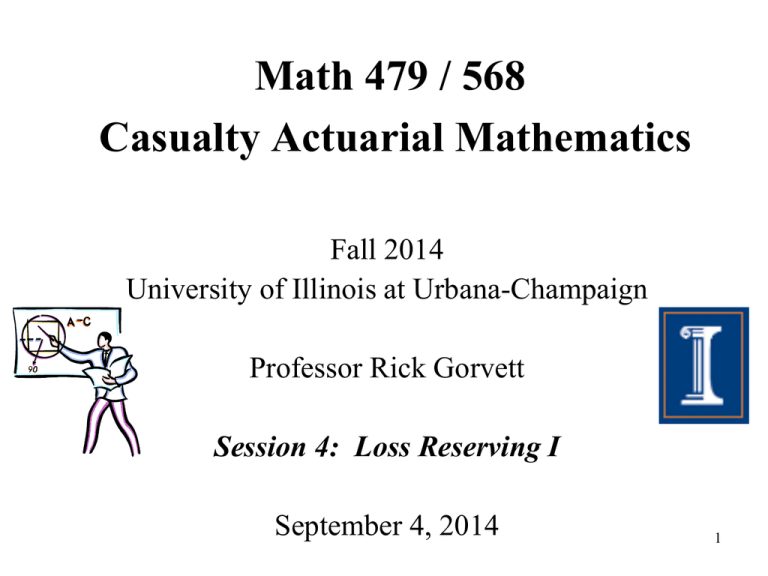
Math 479 / 568 Casualty Actuarial Mathematics Fall 2014 University of Illinois at Urbana-Champaign Professor Rick Gorvett Session 4: Loss Reserving I September 4, 2014 1 Agenda • Purpose of Loss Reserving • Loss data • Types of reserves • Key dates • Types of data • Reserving issues • The basic loss development technique 2 Purpose of Loss Reserving • To determine the loss reserve, as of a certain date, associated with claims incurred by the insurance company on or prior to that date – Claims incurred on earned premium – Balance sheet impact • Biggest liability item for insurance companies • Larger reserve smaller surplus (equity) – Income statement impact 3 Loss Data • Types of loss data – – – – Paid losses Incurred losses Allocated loss adjustment expenses (ALAE) Other expenses • Basis of loss data – – – – Accident year Policy year Calendar year Report year 4 Types of Reserves • Provisions for claim obligations associated with: – – – – – Case reserves Future development on known claims Re-opened claims Incurred but not reported (IBNR) Reported but not yet recorded 5 Key Dates in the Life of a Claim • Accident date • Report date • Activity dates – Reserve set up or changed – Payments made • Closed date • Re-opened date (occasionally) 6 Types of Data for Loss Reserving • Type of data used can vary with the reserving technique • Loss development triangles are the traditional context within which loss reserves are estimated and analyzed • General description of process – Accident / policy year losses at sequential valuation dates – Age to age factors (link ratios) – To-ultimate loss development factors 7 Types of Data (cont.) • Types of loss data analyzed – Case incurred losses (and possibly ALAE or even LAE) – Paid losses • For both: cumulative versus incremental – Claim counts • Paid versus reported • Cumulative versus incremental – Average claim size (severities) • Paid versus incurred • Open versus closed claims 8 Reserving Issues • • • • Availability of data Volume of data How to treat large losses Other data anomalies – including possible errors! • Line of business • Claim handling procedures – Reserving philosophies – Payment philosophies • Underwriting considerations • Legal / judicial climate 9 The Basic Loss Development Technique • Loss development method – Accident year – Policy year – Note: loss development techniques can be performed on any or all of the following (and more) bases: • Paid losses • Case incurred losses • Frequency (claim counts) and severity (average claim size) 10 Paid Loss Development Triangle Accident Year 12 2002 2003 2004 2005 2006 100 140 200 250 290 Maturity (months) 24 36 48 190 290 410 500 300 420 600 362 500 60 380 11 Age-to-Age Development Factors (Link Ratios) Accident Year 12-24 24-36 36-48 48-60 60-Ult. 2002 2003 2004 2005 1.900 2.071 2.050 2.000 1.579 1.448 1.463 1.207 1.190 1.050 Average 2.005 1.497 1.199 1.050 Selected 2.000 1.500 1.200 1.050 1.000 12-Ult. 24-Ult. 36-Ult. 48-Ult. 60-Ult. 3.780 1.890 1.260 1.050 1.000 To-Ult. 12 Projection of Ultimate Losses and Loss Reserves Accident Year Loss @ 12/06 2002 2003 2004 2005 2006 380 500 600 500 290 ===== 2,270 Total Projected Ultimate LDF Loss 1.000 1.050 1.260 1.890 3.780 380 525 756 945 1,096 ===== 3,702 Projected Loss Reserve 25 156 445 806 ===== 1,432 13 General Loss Development Approach • Loss development triangle • Age-to-age factors (link ratios) – Approaches to selecting factors – e.g., • • • • Straight average Average of last three years (Middle) 3 of 5 years Weighted average (by dollars) • To-ultimate loss development factors • For each (accident) year: (actual loss) × (LDF) = estimated ultimate loss • Reserve = (ultimate loss) – (to-date paid loss) • IBNR (broad def’n.) = (ultimate loss) – (case 14 incurred loss) CAS Exam 6, Fall 2007, #7 15 CAS Exam 6, Fall 2008, #9a 16 CAS Exam 6, Spring 2004, #2 17 Next Time • Loss Reserving II • Other techniques • Chapter 5 of Foundations of Casualty Actuarial Science 18

